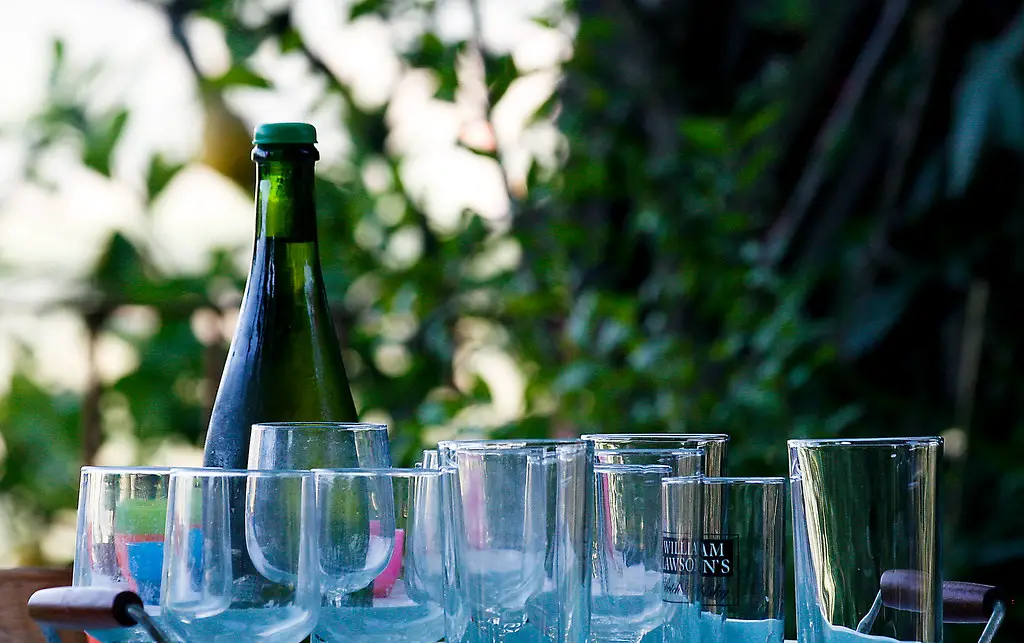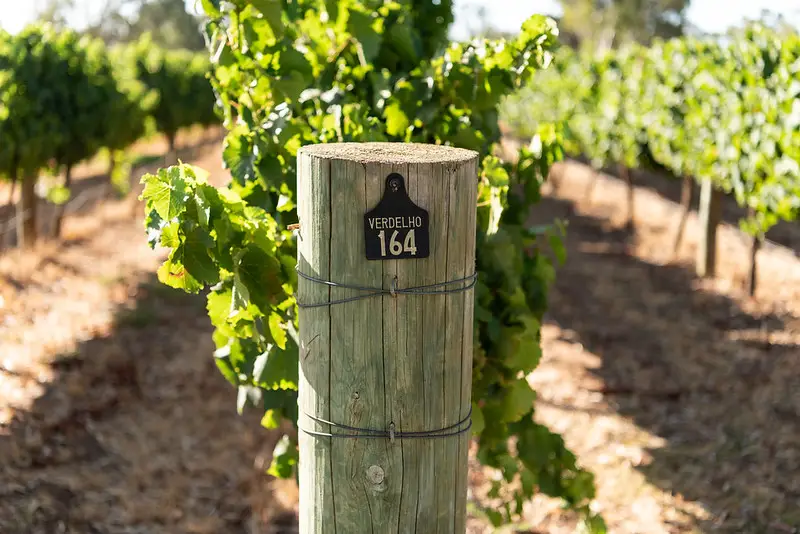Portuguese wines. The first image that comes to mind is the verdant rolling slopes of the Douro, where picturesque vineyards plant their crops and esteemed wineries host Portuguese red blends. But look past this picture-perfect image, and you’ll find a world of Portuguese white wine grapes that are sure to impress even the most discerning of connoisseurs.
Vinho Maduro vs Vinho Verde
One of the most famous Portuguese exports is vinho verde, ‘green’ wine which is aged for only a few months after the coelha (harvest).
Vinho Verde is not a grape, nor is it a specific variety: it refers to young wine that comes from the Vinho Verde DOC region. And it is usually white wine, made from a combination, but not always, of some of the grapes listed below.
Click for our guide on how to pair Vinho Verde with food!
On the other hand, the Portuguese refer to vinho maduro, or mature wine, to mean aged white wine in the classic sense. There are plenty of mouth-watering whites expressed by Portuguese white wine grapes, like Bical and Fernão Pires.
List of Portuguese White Wine Grapes

Now you know the different types of Portuguese whites, here’s a list of white wine grapes from Portugal:
1. Alvarinho
Alvarinho is the Portuguese term for Spanish Galicia’s world-renowned Albariño grape. This grape grows along the most northerly stretch of Portugal’s Atlantic coast, resulting in a crisp acidity that makes it perfect for expressing young vinho verdes, or even aged light white wines.
Portuguese alvarinho wine could even be modestly sparkling, a result of bottling with carbon dioxide, or imbued with the salt waters of the nearby Atlantic ocean, making for an aromatic and refreshing white that pairs beautifully with fresh seafood. Expect notes of citrus and pear on the palette.
We recommend: This grape is unique in that Portuguese wines – whites included – are very rarely expressed as single varieties. Alvarinho breaks that trend, and a Joao Portugal Ramos Alvarinho 2018 provides the perfect introduction to this keen northerly grape.
2. Verdelho
You’re probably familiar with Madeira wine, a sweet wine delicacy from the Portuguese island archipelago of Madeira.
Verdelho was the traditional grape used in the production of fortified Madeira wines, but the great phylloxera blight in the 19th century put a stop to that. These days, Verdelho has embarked on adventures in the New World, with more plantings in California, Australia and New Zealand than in Europe.
This has not prevented shrews winemakers from planting this traditional Portuguese white wine grape in a modern environment – just look at the growing list of producers who are refashioning Verdelho into something new and distinctly Portuguese.
We recommend: Look to the Alentejo for the best modern Portuguese expression of the historic Verdelho grape – the Malhadinha Nova winery has produced fine single-caste Verdelhos for your oenological pleasure.
3. Rabigato
Rabigato is a Douro classic, even more valued because, with each harvest that goes by, the variety becomes rarer and rarer. Many wineries that employ the grape are now shifting their focus to reveal the finer qualities of Rabigato in their productions.
Unique notes of shrubbery and mandarin coat the palette, along with a firm acidity and incredible balance that does not come naturally to some of the other Portuguese white wine grapes.
We recommend: Try a Muxagat Os Xistos Altos White 2018 for notes of juniper and flowers that places Rabigato front and center, highlighting its strong, firm composure.
4. Bical
Stand aside, Chardonnay – Bical is one of the great crisp whites of the Portuguese wine revolution. Bairrada leads the charge here, with even pioneering winemakers Filipa Pato and her father, Luis Pato, each producing their own take on this yellow-skinned staple of the Beira Atlantico.
With its bouquet of nectarines and peach-pervaded goodness, Bical is a contender for the standout Portuguese white. Age Bical in oak, however, and you have a crisp, refreshing white that stands up to globally prolific grapes like Chardonnay and the rest.
We recommend: Filipa Pato’s Bical is blended with Arinto to create a wonderfully complex white that’s fit for sipping on warm Portuguese evenings. Definitely one to try if you want to experience the true character of the great Bical grape.
5. Loureiro
The Portuguese Loureiro flower (otherwise known as bay laurel, or perhaps more recognizably, the bay leaf) is the main aroma that wafts from the glasses of wines made from this beguilingly floral Portuguese grape variety.
The Loureiro grape is mostly planted in the Vinho Verde DOC – the largest DOC in the country – and proudly takes center stage as one of the main grapes in the famous Vinho Verde blends of the region. It imparts a floral, orange-tinged bouquet to the blend, which is even more pronounced in the increasingly popular single varietal Loureiro bottles on the marketplace.
We recommend: You can find a true single caste Loureiro at typical vinho verde prices. Try the offering from Casal de Ventozela, a small winery in the Ave Valley at the heart of the Vinho Verde DOC.
6. Arinto (Pedernã)
Often blended with Bical, Arinto (called Pedernã when grown in the Vinho Verde DOC) makes a good Portuguese alternative to Riesling. Lemons and apples are the signature notes here, which makes Arinto a useful blending grape for the production of fresh vinho verdes and other more mature whites.
Arinto doesn’t settle for being solely a blending grape, though; producers in the Bucelas region, north of Lisbon, are passionate about this variety. The Brotherhood of Bucelas Arinto was set up in 2008 to promote the discovery of Arinto wines and viticultural techniques in the region alongside the economic and social life of the village of Bucelas.
We recommend: Wineries in the Alentejo have produced Arinto-led wines that differentiate from the more traditional pickings in the Vinho Verde and Bucelas regions – a 2012 bottle of Alentejo Dom Rafael Branco is a great choice.
7. Fernão Pires
Fernão Pires is the Portuguese white wine grower’s best friend. It can be found growing across the length, width and breadth of the country – although it is most prominent in the Tejo, the region around Lisbon in the heart of the country – and manages to sneak into all manner of white and sparkling wines on Portuguese supermarket shelves.
Powerful citrus, lime and tangerine notes characterise a good Fernão Pires. Its versatility has led to a fledgling New World wine presence for this Portuguese classic, and Fernão Pires can now be found growing in Australia and South Africa.
You might also see Fernão sold as Maria Gomes – this is the name given to Fernão Pires in the Bairrada and Beira Atlântico regions. Although they are technically the same wine, you can expect wine sold as Maria Gomes to be somewhat softer on the palette than the intensely vibrant Fernão Pires – this is on account of the sand and clay soils of the Bairrada.
We recommend: Fernão is in abundance, but try one from Quinta Varzea da Pedra for a Fernão-forward offering. Use the intoxicating aromatics to your advantage and pair with a fruit-infused dish like coconut hotpot or garlic-lemon pork.
8. Moscatel Graúdo (Moscatel de Setúbal)
Moscatel de Setúbal is Portugal’s answer – or perhaps contribution – to the ubiquitous muscatel variety. There are two other Moscatel varieties in Portugal (as with lots of things in Portuguese wine, though, it’s not that simple), but Moscatel de Setúbal is the most prominent and holds a special place in all Portuguese white wine lovers’ hearts.
The grape used is Moscatel Graúdo. It’s grown mostly in the Setúbal Peninsula region (in fact, it must be grown there in order to gain the Moscatel de Setúbal DOC status). The grapes undergo a period of skin-on fermentation before being fortified with grape brandy. It is then aged for a minimum of about three years – although this can extend all the way up to twenty years, if desired – to produce a highly citric, aromatic white wine, high in alcohol and best served chilled as a dessert wine.
Moscatel Graúdo can be used as a blending grape, too – it is commonly blended with Fernão Pires to create very zesty, fruit-driven white wines.
We recommend: You must try the 10-year aged Moscatel de Setúbal from local winemaker António Saramago to give yourself a taste of the unique pine and fig notes that can develop with a well-aged Moscatel de Setúbal.
9. Encruzado
Encruzado takes all of the signatures of Portuguese whites and compounds them into a perky, mineral-rich explosion of acid-led flavor. This is probably why Encruzado is most commonly employed in Portuguese field blends – usually from the Dão region, its indigenous home.
Things have started to change, however, and an increasing number of local producers are working to extract singular, expressive wines from Encruzado alone. For this reason, Encruzado might just be Portugal’s best-kept secret. If the recent hype around long-shunned Portuguese blending grapes is anything to go by, though, Encruzado’s low-key status might be coming to an end.
We recommend: Encruzado is normally used as a support grape for Dão blends, but a 100% Encruzado bottle produced by Villa Oliveira will give you a rare taste of Encruzado proper from a modern, forward-thinking winery.
However, the main purpose of this article is to highlight some of the familiar varieties that pop up again and again – many of them which are now part of the renaissance of Portuguese wine, long-overlooked for their single varietal potential. Portugal is the winemaking country where millennia of tradition meets young producers and innovating techniques, paving the way for a reframing of traditional grape varieties like Alvarinho and Encruzado.
Our best pick? An alvarinho-forward vinho verde with simple, salted bacalhau. Perhaps that’s all you actually need to experience the vibrancy of a great Portuguese white wine.
Header photograph by Bryce Walker, licensed under a CC BY 2.0 license

[…] a similar vein, you could go down the route of looking to white wines with a sharp acidity. There are an array of Portuguese white wines from the Vinho Verde and and Douro wine regions renowned for their fresh, crisp Atlantic Ocean […]